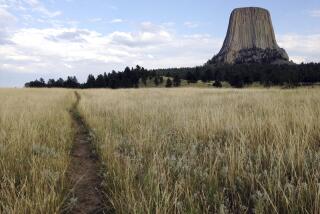Don’t Dilute Seismic Safety, Panel Says
The state Seismic Safety Commission, meeting here for a two-day hearing on the San Simeon earthquake of Dec. 22, has issued a strong denunciation of moves in the Legislature to scale back provisions of the state’s Field Act, which requires school buildings to have seismic safeguards.
The commission voted to oppose a bill by state Sen. Jack Scott (D-Altadena) that would exempt community colleges from the same standards that apply to school buildings serving kindergarten through 12th-grade students.
Bruce Clark, a former commission chairman, said the panel should “violently” oppose any such change, and commission Vice Chairwoman Lucy Jones, the seismologist who directs the U.S. Geological Survey office in Pasadena, declared that such modifications the Field Act “would end up by costing people’s lives.
“It is that significant,” Jones said of preserving the Field Act, which was adopted after the 1933 Long Beach earthquake severely damaged many school buildings.
Another commission member, Daniel Shapiro, said Gov. Arnold Schwarzenegger needs “to be put on a learning curve” about defending state seismic protections that have allowed California to escape the high number of fatalities that have occurred in other parts of the world during large earthquakes.
Jason Murphy, an aide to Scott, said the senator has decided to change the language of his bill and that seismic-safety commissioners “may not be dissatisfied with the result.”
While acknowledging that there is pressure to save money in the state’s fiscal crisis, several commission members said weakening seismic safety regulations is not a good way to go about it.
In public comments at the opening session of the meeting, Lyle Gardner, a local resident, said he favors putting placards on all unreinforced masonry buildings that have not been retrofitted.
Jones said she consciously avoids entering unretrofitted masonry buildings, knowing that they are the structures most vulnerable in quakes.
Two women were killed during the San Simeon earthquake when an unretrofitted building in Paso Robles collapsed.
Reporting to the commission on the lessons of the earthquake, Jay Love, a seismic engineer, said one of the most alarming findings was that modern wood-frame houses, long thought to be resistant to major earthquake damage, had not fared as well as expected.
Examination of some damaged houses showed that they were bolted to foundations, but that plywood installed to provide lateral strength was not as carefully secured as it should have been.
Love displayed a picture of one Atascadero home where the plywood had been held in place by only two nails, both of which gave way.
“The idea of protection is there, but construction quality too often is poor,” he observed.
In other testimony, local officials and commissioners expressed surprise that the regular telephone system seemed to have withstood the earthquake better than the cellular phone system in the first hours after the quake. Local officials said this was because some cellular relay points were on structures that had been damaged.
More to Read
Sign up for Essential California
The most important California stories and recommendations in your inbox every morning.
You may occasionally receive promotional content from the Los Angeles Times.










